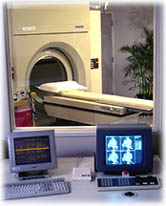![]()
 2401 Pennsylvania Avenue, NW
2401 Pennsylvania Avenue, NW
Washington, D.C. 20037
(202) 467-0929
FAX: (202) 469-0936
| The Coronary Artery Disease Risk Assessment Program Heart disease is the leading cause of death among both men and women in the United States. Current estimates are that more than 70 million Americans suffer from some form of cardiovascular disease. In as many as 150,000 cases a year, the first, last and only symptom of coronary artery disease is a fatal heart attack. This "silent killer" is a slow, progressive disease that can begin early in life and go undetected for years. Atherosclerosis, or a build-up of deposits on the inner lining of an artery, is medically proven to be a "clinical marker" for coronary artery disease. Fortunately, this disease can be treated and even reversed if it is detected in time. Traditional testing methods can only suggest a probability of atherosclerosis. They cannot determine whether or not the disease is actually present. An EBCS Scan, a HeartScan, can find hidden coronary artery disease long before you feel any symptoms. In time for you and your doctor to do something about it. The EBCS Scan by Electron Beam Tomography HeartScan-Washington D.C. uses the most advanced non-invasive technology available, the EBCS Scan, to determine the presence and extent of the atherosclerotic process in the coronary arteries. Recent scientific studies suggest that this test may be more powerful than any other available non-invasive test in predicting heart attacks in apparently healthy people. The test can only be performed using HeartScan's patented technology, the Imatron Electron Beam Tomography scanner. Our process is ten times faster than conventional methods, so it can take a "freeze-frame" photograph of the heart and coronary arteries. The scan is triggered by your electrocardiogram and is completed in a single breath hold. The x-ray dose is minor, approximately equivalent to one abdominal x-ray. HeartScan consulting cardiologists can offer written recommendations to you and your physician regarding management of your risk factors and ways of improving your chances of avoiding a future coronary event. |
